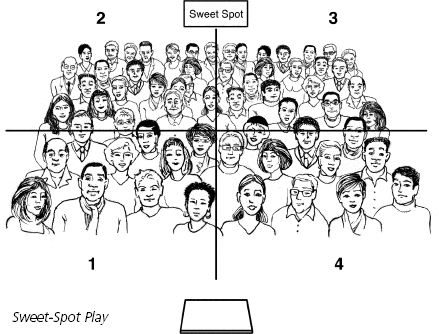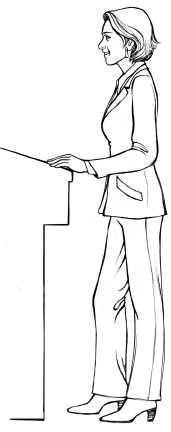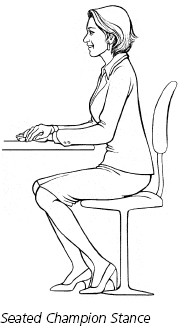The Well-Spoken Woman (12 page)
Read The Well-Spoken Woman Online
Authors: Christine K. Jahnke

Eye Contact Cheating
- Swinging your head from side to side. You look like you are watching Venus and Serena Williams play tennis on TV.
- Rapid eye darts. The movement will tire out your neck and eyes. Plus, nobody in the room feels like you are looking at them.
- Head buried in notes.
- Searching the ceiling for the answers.
- Turning your back to the audience to read from PowerPoint slides.
“Four-Box” Play
The “four-box” play ensures you look at everyone in the room, no matter the audience sizeâten or ten thousand. The four-box play teaches you how to make quality eye contact with individuals by looking in all areas of the room but looking only at one person at a time. Implement the four-box play by mentally drawing a line across the middle of the room horizontally and then vertically, as you see below, to divide the room into four sections or boxes. Envision yourself standing in the rectangle at one end of the room.
Now that the play is diagrammed, here's how it is run. Each box is numbered to represent an area with people in it. Start by looking toward the first box and talking to one person seated in it. Then, move on to box two, again looking at one person. Work your way around the room in a clockwise fashion. When you look at one person, keep your eyes steady on that person until you finish a sentence or a thought. Keep looking at one person until
you get a whole sentence or idea out. The technique requires that you look at individuals a bit longer than you do in one-on-one conversation.

Initially, it may feel like you are overdoing it by staring. Researchers say we break eye contact every two or three seconds when talking one-onone. In front of an audience, however, you don't want to cheat by flitting your eyes around the room. Extending the contact projects confidence, especially when you hold your eyes on one person until you finish your sentence. The four-box play gives you a way to practice so you remember to hold eye contact longer than you are accustomed to.
After you've moved around all of the four boxes, go back to the first box. This time, look at a different individual seated in the area. Same thing for box two; look at a different person. You don't want to keep looking at the same people in each of the boxes. Run the drill several times before using it with a live audience. With practice, you get into the swing and will not need the clockwise pattern. Continue using the four boxes to ensure you hit all areas, but no longer move from box one to two to three to four.
Instead, look at someone seated in box two, then at someone in box four or box one. The clockwise movement isn't the key. What is key is to hold eye contact steadily on one person until you complete a thought.
“Sweet-Spot” Play
Use the “sweet-spot” play when you want to make eye contact with everyone at once. First, locate the sweet spot. The sweet spot is the area directly in front of you, slightly above the head of the person seated farthest away. The sweet spot is in the center of the back of the room. When you direct your eye contact to the sweet spot, you appear to be looking at everyone in the room when actually you are looking at no one.
Looking at the sweet spot ensures that your chin is slightly raised. This helps you project to the entire room. Use the sweet spot at the beginning when you greet the audience and at the end to wrap up. Additionally, use the spot anytime during the presentation when you have an important point you want to share with everyone.

Step 2: Posture
On the sidelines, Coach Summitt says she often looks like “a cross between a traffic cop and an orchestra conductor,”
6
getting her whole body into the action. She prefers to stand so she is visible to everyone in the basketball arena. Plus, she feels closer to the game and is in a better position to communicate with her players one-on-one. The coach purposefully uses her posture to convey conviction and strength, especially during stressful stretches of the game. How you stand may be communicating more than you think.
Posture Imperfect
- The Mae West:
When someone stands with one hand on her hip, with the hip jutting out, don't you expect to hear, “Why don't you come on up and see me sometime?” - Crossed ankles:
This is a sign of insecurity and can be dangerous. Speakers with ankles crossed while standing risk falling on their face if they attempt to step forward. - Sway:
Tilting like a seesaw makes you look as if you are speaking from the deck of the
Titanic.
Yes, the ship is going down. - Superwoman:
Hands on hips, chest puffed out and up, feet shoulder width apartâthe stance feels empowering but looks comical, especially if you are petite. - Cocked or tilted head:
You may be listening, but you look submissive and remind people of a curious dog. - Ten-hut!
No need to snap to attention. If your arms are held rigid, back ramrod straight, and shoulders tense, it will be a long presentation. At ease. - Fig leaf:
The position of Eve's daywear is not the place for your hands. The stance provides protection but communicates insecurity. - Locked-down arms:
Crossing your arms against the chest makes you look defensive or bored.
Champion-Stance Play
The champion stance is not just for First Ladies. It will help you project confidence with a relaxed yet commanding posture. Try the stance right now. Stand up and place one foot slightly in front of the other. Experiment to figure out which foot you prefer to place in the forward position. Pick whichever one feels more comfortable. Then, stand up straight with your body weight resting slightly on the back leg. Avoid positioning the feet shoulder width apart, which locks the knees in place. The champion stance provides the loose-kneed stance of a tennis player or downhill skier. With the knees loose, you feel more relaxed and look less rigid. If the knees are locked, nervous tension can run up the spine and settle in the neck and shoulders.

Now, with the feet in place and weight on the back leg, position your face forward. Pretend a string is attached to the lower part of your spinal column. The string extends up the spinal cord, through the neck, and out the top of the head. Project the string straight up from the crown of your head into the ceiling. Next, drop your shoulders back slightly. Don't stick your chest out. Just drop your shoulders back with your arms hanging loose at your sides. The shoulder drop-back is the secret to carrying yourself like a world champion.
Champion Stance
- Position feet, one in front of the other.
- Place weight on back leg.
- Face forward.
- Head up.
- Shoulders drop back.
- Weight moves forward.
- Smile.
At this point, you likely will feel as if you want to move your body weight forward onto the front foot. Forward movement keeps the knees loose and appears interactive because you are moving toward the audience. This stance also prevents you from swaying side-to-side. Try the stance again in front of a mirror.
To Sit or Stand?
Whether courtside, at Carnegie Hall, or in a local community center, you will look and sound better if you adopt the champion stance. Standing posture presents a more dynamic presence and gives you more control. This is particularly true if there will be a question-and-answer session. However, in some forums it is more appropriate to remain seated, such as in a panel discussion. Fortunately, there is a champion stance for seated posture, too, to keep you from slumping in your chair. Don't cross your arms and legs as if you have been stuffed into a small seat on a crowded airplane. Rather, sit up straight with shoulders dropped back and down. Dropping the shoulders is what helps you look like a pro. Then tilt forward from the waist toward the audience keeping your back straight. Don't slouch or hunch your shoulders; just lean forward a couple of inches from the waist.

When seated behind a table or desk, put your hands and forearms on the table
in front of you. Position your forearms so they form a V on top of the table. Don't place your arms parallel to your body, because this position will cause you to hunch your shoulders. With the forearms in the V position, put one hand on top of the other. Avoid interlacing your fingers.
Seated Champion Stance
- Sit up straight.
- Drop back shoulders.
- Lean forward from the waist. Place hands and forearms on the table in V position.
- Put one hand on top of the other.
Step 3: Movement
Movement works when it is purposeful, not random. Purposeful movement is interactive, conveys enthusiasm, and keeps the audience attuned. They will shift in their seats to follow you. But you must be aware of how you are moving and where you are going. Otherwise, they will worry that you are going to stumble on an electrical cord, or that you will find yourself wandering in front of the PowerPoint screen and being blinded by the projection light. There are two basic ways to move. Let's start with movement behind a lectern. Then we'll discuss stage movement.
When speaking from a stationary position, many presenters develop tunnel vision as they lapse into speech mode. Grasping the sides of the lectern, they clamp down, and movement is limited to neck turns and eye darts. This is an unnatural stance that appears stiff. Most people do not stand motionless in everyday conversation. Let's revisit the four-box play so we can add a second layer of technique. When you look at someone seated in the box-one area, don't turn your neck. Rather, look at the person by turning from the waist. This is the ultimate secret to appearing engaged and relaxed. When conversing with someone in person, you face that person. Use the same movement in front of an audience.
Waist-Turn Play
To execute the waist turn, twist enough so that your shoulders are squared toward the person you are looking at. Let go of the lectern, and this will be easier to do. Then, when you turn to look at someone in another box, again turn from the waist. The waist turns eliminate excessive neck movement. If you feel your neck turning, that is a signal that you need to get the body moving. The body turns put you face-to-face with individuals, and they feel like you are looking at them because you are.
